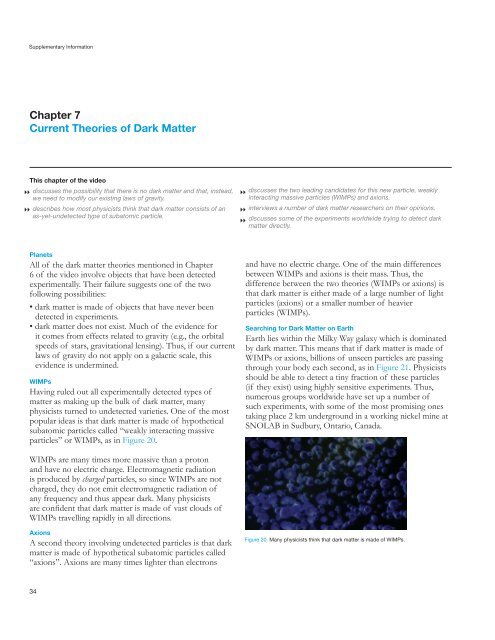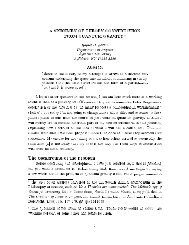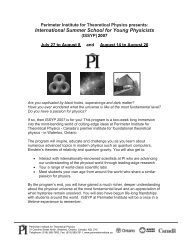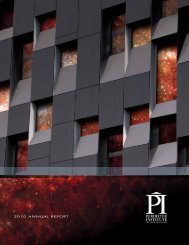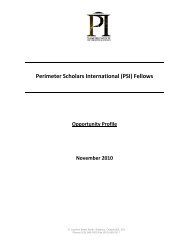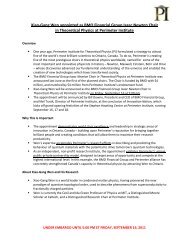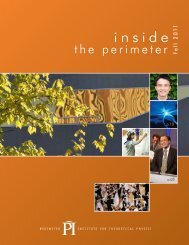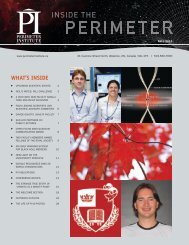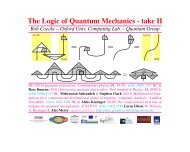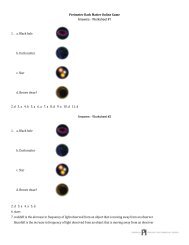Dark Matter Teacher Guide - Perimeter Institute
Dark Matter Teacher Guide - Perimeter Institute
Dark Matter Teacher Guide - Perimeter Institute
Create successful ePaper yourself
Turn your PDF publications into a flip-book with our unique Google optimized e-Paper software.
Supplementary Information<br />
Chapter 7<br />
Current Theories of <strong>Dark</strong> <strong>Matter</strong><br />
This chapter of the video<br />
discusses the possibility that there is no dark matter and that, instead,<br />
we need to modify our existing laws of gravity.<br />
describes how most physicists think that dark matter consists of an<br />
as-yet-undetected type of subatomic particle.<br />
Planets<br />
All of the dark matter theories mentioned in Chapter<br />
6 of the video involve objects that have been detected<br />
experimentally. Their failure suggests one of the two<br />
following possibilities:<br />
• dark matter is made of objects that have never been<br />
detected in experiments.<br />
• dark matter does not exist. Much of the evidence for<br />
it comes from effects related to gravity (e.g., the orbital<br />
speeds of stars, gravitational lensing). Thus, if our current<br />
laws of gravity do not apply on a galactic scale, this<br />
evidence is undermined.<br />
WIMPs<br />
Having ruled out all experimentally detected types of<br />
matter as making up the bulk of dark matter, many<br />
physicists turned to undetected varieties. One of the most<br />
popular ideas is that dark matter is made of hypothetical<br />
subatomic particles called “weakly interacting massive<br />
particles” or WIMPs, as in Figure 20.<br />
WIMPs are many times more massive than a proton<br />
and have no electric charge. Electromagnetic radiation<br />
is produced by charged particles, so since WIMPs are not<br />
charged, they do not emit electromagnetic radiation of<br />
any frequency and thus appear dark. Many physicists<br />
are confident that dark matter is made of vast clouds of<br />
WIMPs travelling rapidly in all directions.<br />
Axions<br />
A second theory involving undetected particles is that dark<br />
matter is made of hypothetical subatomic particles called<br />
“axions”. Axions are many times lighter than electrons<br />
34<br />
discusses the two leading candidates for this new particle, weakly<br />
interacting massive particles (WIMPs) and axions.<br />
interviews a number of dark matter researchers on their opinions.<br />
discusses some of the experiments worldwide trying to detect dark<br />
matter directly.<br />
and have no electric charge. One of the main differences<br />
between WIMPs and axions is their mass. Thus, the<br />
difference between the two theories (WIMPs or axions) is<br />
that dark matter is either made of a large number of light<br />
particles (axions) or a smaller number of heavier<br />
particles (WIMPs).<br />
Searching for <strong>Dark</strong> <strong>Matter</strong> on Earth<br />
Earth lies within the Milky Way galaxy which is dominated<br />
by dark matter. This means that if dark matter is made of<br />
WIMPs or axions, billions of unseen particles are passing<br />
through your body each second, as in Figure 21. Physicists<br />
should be able to detect a tiny fraction of these particles<br />
(if they exist) using highly sensitive experiments. Thus,<br />
numerous groups worldwide have set up a number of<br />
such experiments, with some of the most promising ones<br />
taking place 2 km underground in a working nickel mine at<br />
SNOLAB in Sudbury, Ontario, Canada.<br />
Figure 20 Many physicists think that dark matter is made of WIMPs.


